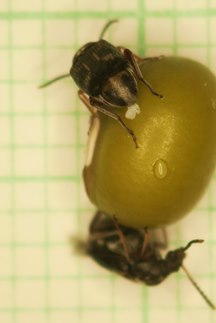Egg size plasticity in bean beetles (Callosobruchus maculatus): Does host bean species matter?
ABSTRACTIn this exercise, students design a series of experiments (1) to test whether female bean beetles adjust the size of their eggs on different host bean species and (2) to determine whether differences in egg size based on host bean species are optimal. Most often, students design experiments in which different females are allowed to lay eggs on different bean species that vary in nutritional quality. After approximately 6 weeks, students measure egg size, female body size, and emergence success of offspring. Experimental design and initial setup require one laboratory period. Data collection requires 1-2 laboratory periods depending on the number of eggs measured. In class, students discuss approaches to data analysis and analyze their data. Outside of class, they write a scientific paper based on their results in the format of Ecology. AUTHORSChristopher W. Beck1,3 and Lawrence S. Blumer2 1Department of Biology, Emory University, Atlanta, GA 30322 2Department of Biology, Morehouse College, Atlanta, GA 30314 3Corresponding Author: Christopher W. Beck (christopher.beck@emory.edu) CLASS TIMEOne 2-3 hour class period for experimental design and initial setup and 1-2 3-hour class periods 6 weeks later for data collection. OUTSIDE OF CLASS TIMEStudents will spend several hours conducting library research and writing papers based on their results. STUDENT PRODUCTSEach student prepares a written scientific paper in the style of Ecology based on the pooled data from the entire class. If different laboratory groups develop and implement different experimental designs, groups could present posters or oral presentations to the rest of the class. SETTINGThe experiment is carried out entirely in the laboratory. COURSE CONTEXTThe experiment as described is used in a stand-alone upper-level undergraduate ecology laboratory course with a maximum of 12 students. INSTITUTIONThis experiment has been conducted at a mid-sized private research university. Bean beetles have been used in teaching labs across a wide range of institution types. TRANSFERABILITYThis experiment is transferable to other levels, given that it is a guided inquiry exercise. At the lower level, students will need additional support and direction as they design the experiment and analyze data. A simpler version of the experiment that may be appropriate for introductory level undergraduate students. For example, students could examine egg size plasticity among different bean species or between large and small beans of the same species. Bean beetles have been used for other experiments in high school biology classes and are reliable experimental organisms. Other phytophagous insects that are easily reared in the laboratory on a variety of host plants and for which eggs can be easily identified and measured could be used in this experiment. For example, tobacco hornworms, Manduca sexta, and the Brassica butterfly, Pieris rapae, are available through biological supply companies. DOWNLOADSDescription of other Resource Files: ACKNOWLEDGMENTSThis experiment is one of a growing number of laboratory exercises using the bean beetle (Callosobruchus maculatus) as a model species. See www.beanbeetles.org for additional experiments. We thank the ecology students at Emory University who pilot-tested the experiment and provided feedback. This work would not have been possible without prior support of the National Science Foundation to Morehouse College and Emory University (DUE-0535903, DUE-0815135, and DUE-0814373). Any opinions, findings, and conclusions or recommendations expressed in this material are those of the authors and do not necessarily reflect the views of the National Science Foundation. CITATIONChristopher W. Beck and Lawrence S. Blumer. 23 August 2016, posting date. Egg size plasticity in bean beetles (Callosobruchus maculatus): Does host bean species matter? Teaching Issues and Experiments in Ecology, Vol. 11: Experiment #2 [online]. https://tiee.esa.org/vol/v11/experiments/beck/abstract.html |

Female bean beetle laying an egg on a mung bean and a newly laid egg on the surface of the bean. Photograph taken by LS Blumer. full size image |
<top> | |